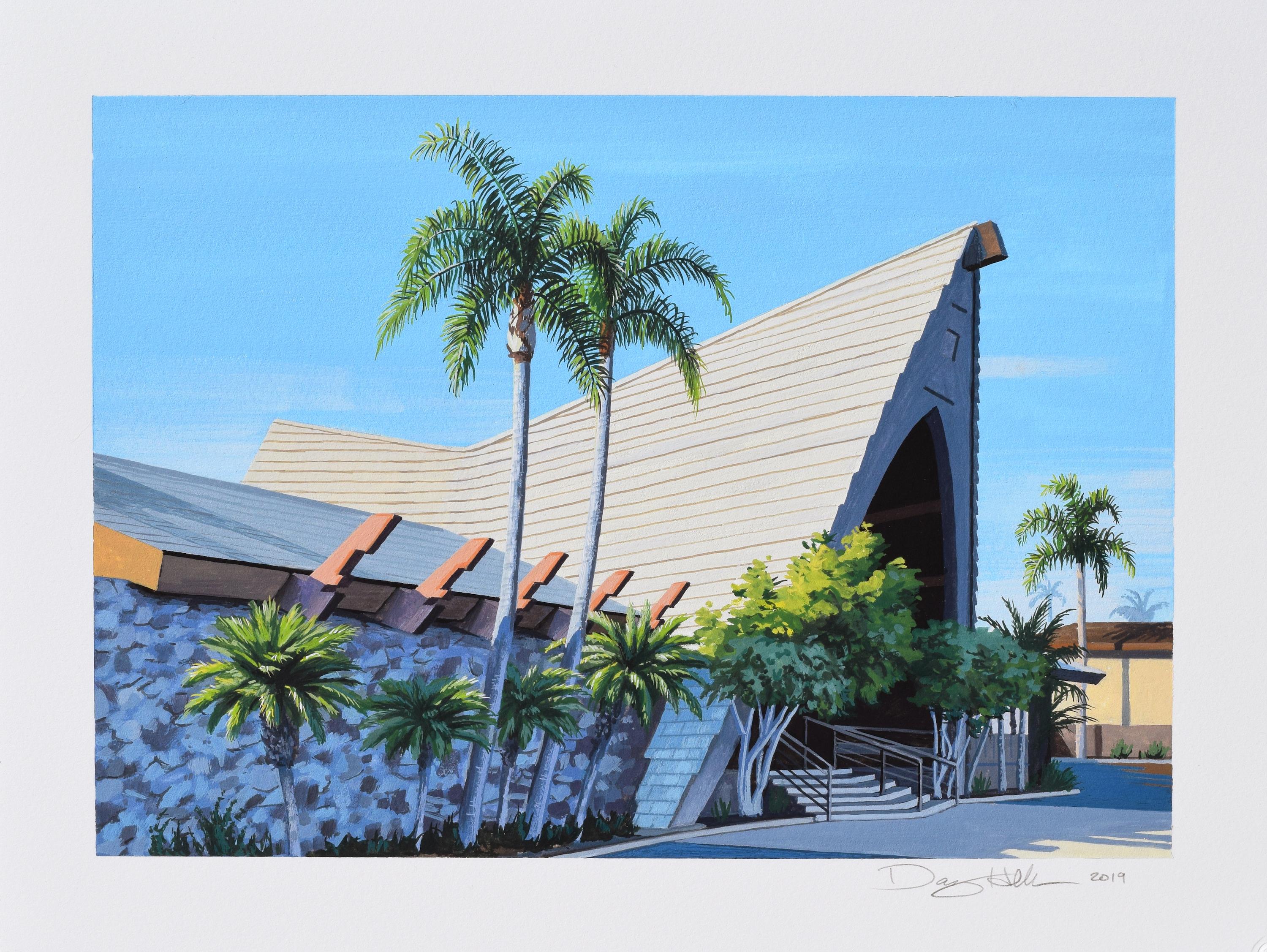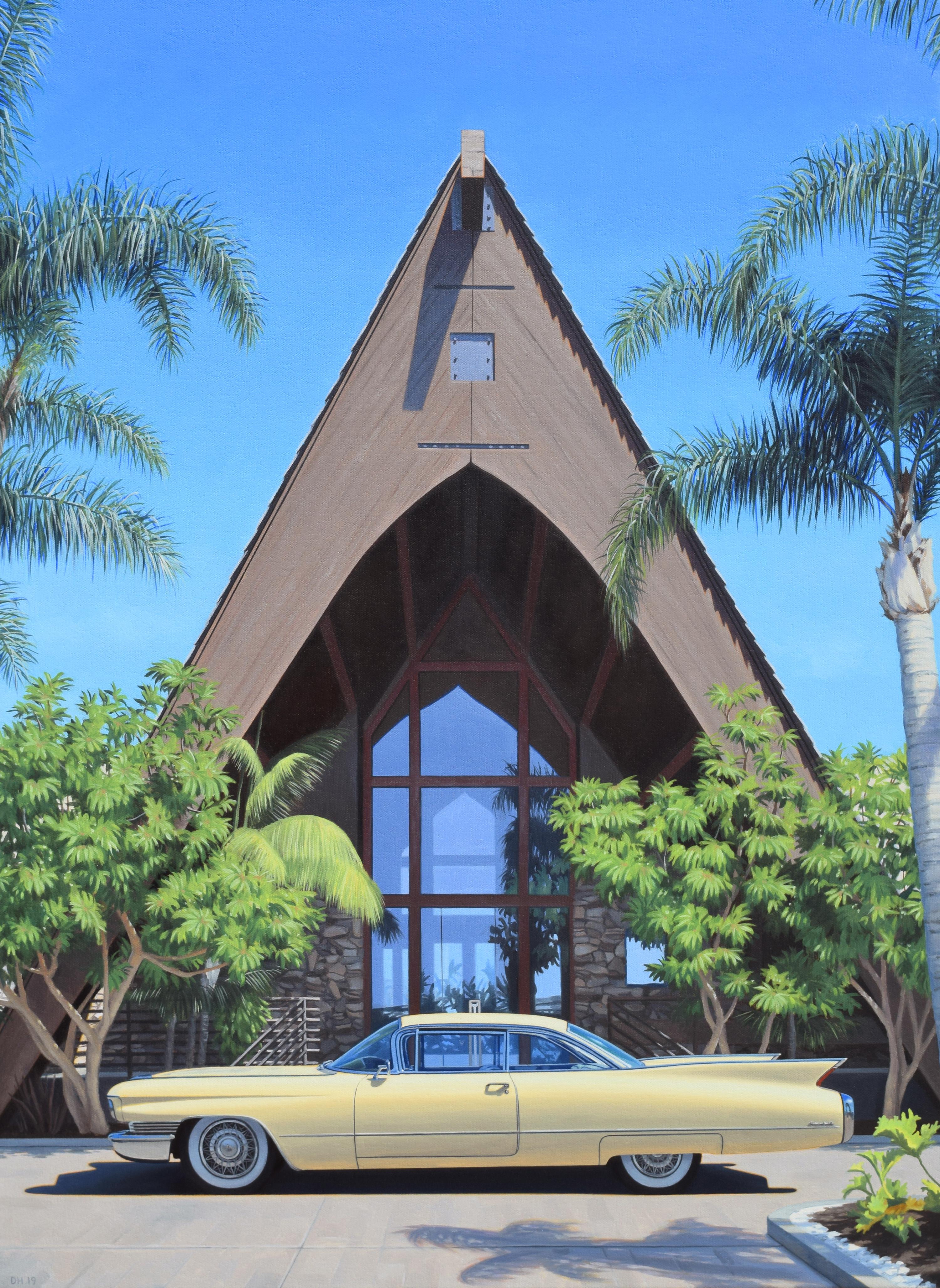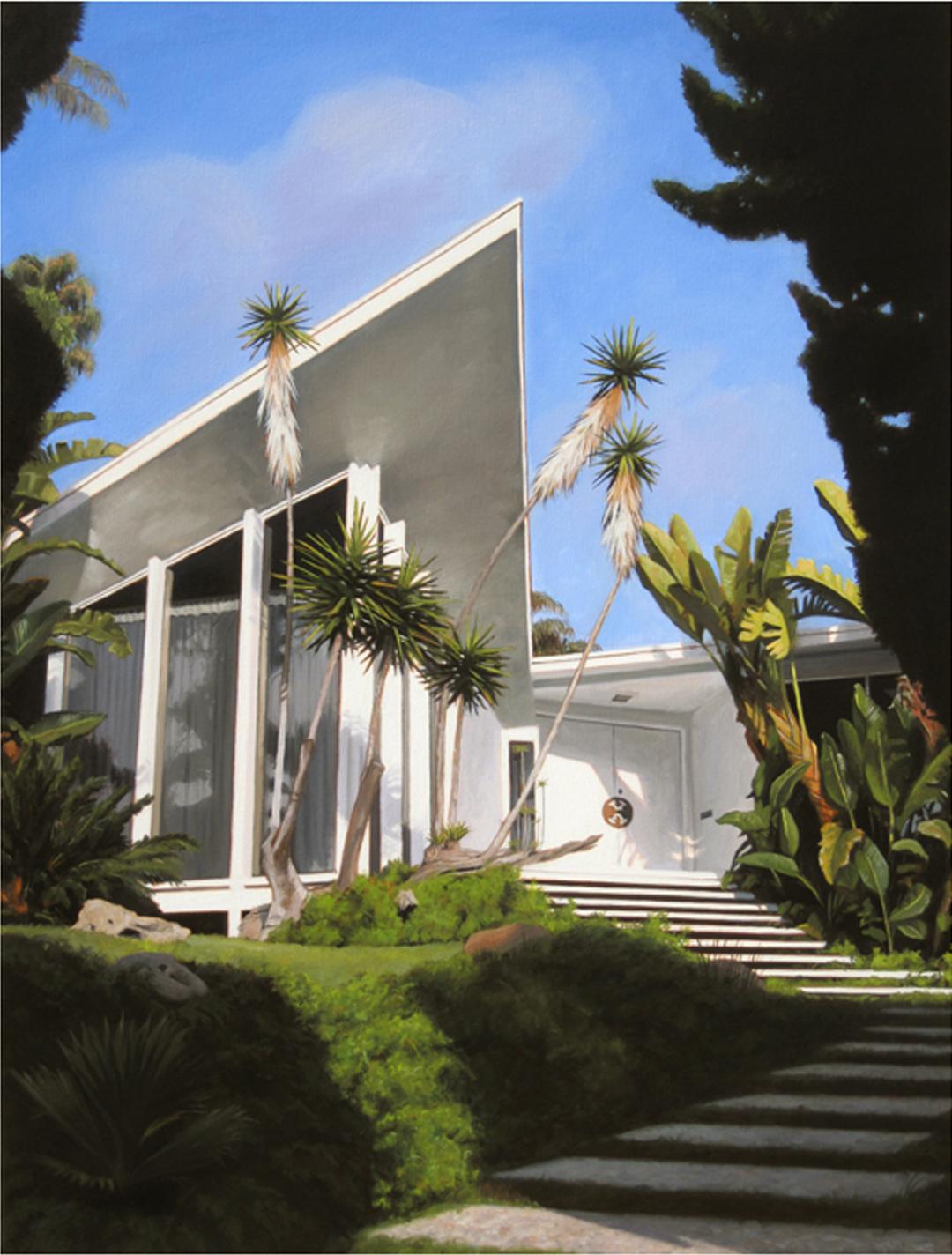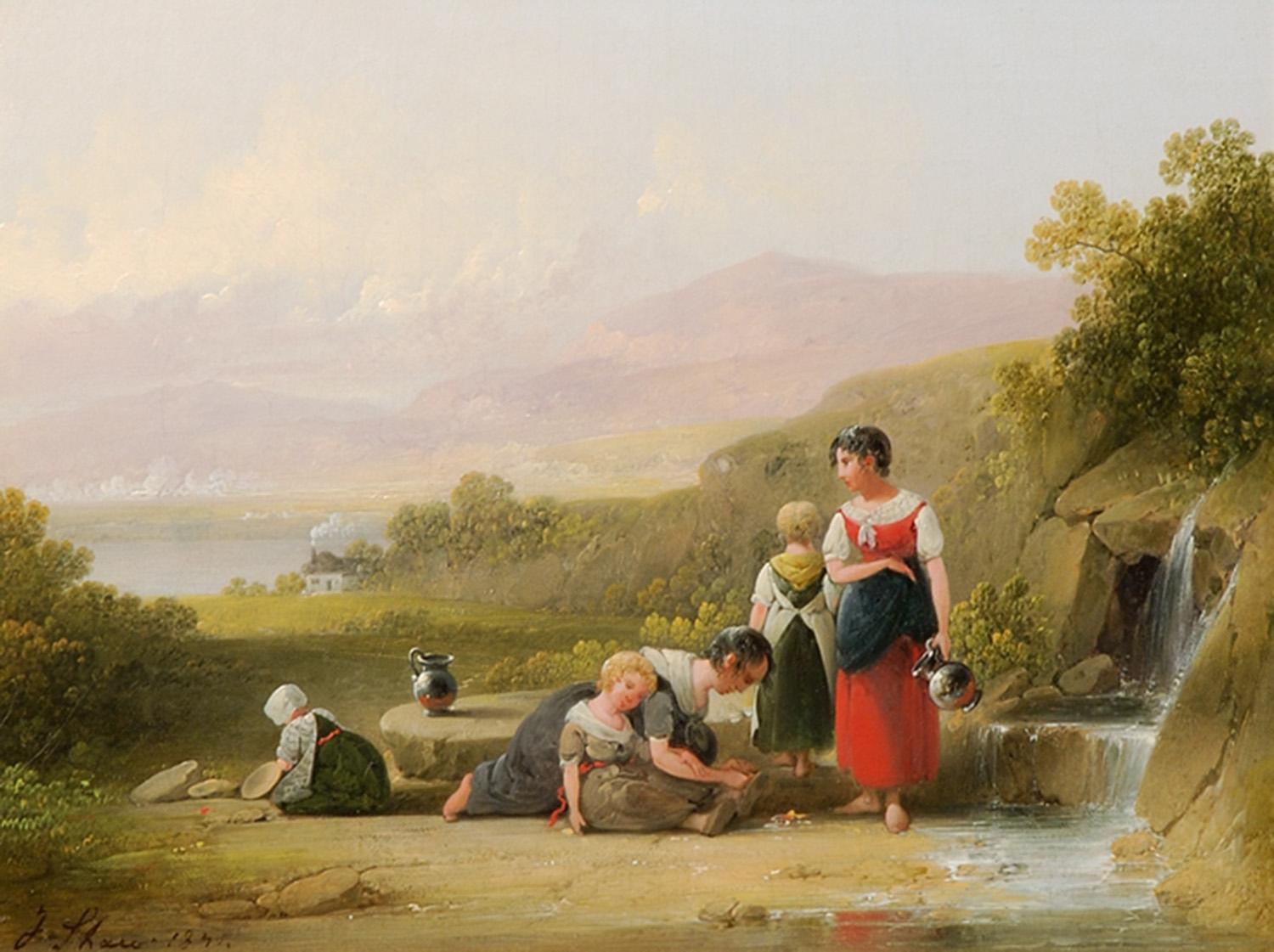Items Similar to "Backyard, Staten Island, New York" Bumpei Usui, Japanase-American Landscape
Want more images or videos?
Request additional images or videos from the seller
1 of 8
Bumpei Usui"Backyard, Staten Island, New York" Bumpei Usui, Japanase-American Landscape1933
1933
About the Item
Bumpei Usui
Backyard, Staten Island, 1933
Signed lower right
Oil on canvas
20 x 24 inches
Provenance:
The artist's estate
Salander O'Reilly Galleries, New York
Arlene Berman, New York
Bumpei Usui was born in Nagano, Japan, in 1889. He told a story of entering the United States by literally jumping off a ship and swimming, which no one ever had any reason to believe wasn't true. In the 1940's he owned and operated a frame shop on 13th Street just east of Fifth Avenue. The headquarters of the Communist Party of America (1919-1946) was next door. During World War II, Usui was not interned but was regularly questioned by FBI agents. Some sources say the frame shop was at 5 East 14th Street, but this is not the recollection of his nephew, George Howard.
Usui, as he was known to family and friends, was not a prolific artist because he worked full time in his frame shop. Through his framing, he came to know many famous artists in New York in the 1940’s and 1950’s. He framed the work of Milton Avery among other peers.
He was a personal friend of Yasuo Kuniyoshi, a well known Japanese-American artist. A portrait that he painted of him in Kuniyoshi's studio is in the Smithsonian American Art Museum in Washington, D.C.
Usui had an extensive collection of Samurai swords. In March of 1978, the apartment he lived in Greenwich with his wife was burglarized, and he and his wife, Frances Pratt, were tied up and held at gunpoint while most of the collection was stolen. He sold the balance of the collection at auction through Sotheby’s in January of 1979.
In 2014, the Metropolitan Museum of Art acquired The Furniture Factory from a New York gallery that had the painting for sale at a price at $150,000. The painting was acquired not for cash but in trade for other works of art from the Metropolitan’s collection. The painting in now on exhibit in the Contemporary Art Galleries of the Met.
He divorced his first wife, Lucille Bumpei, in 1943. He married Frances Elizabeth Pratt in 1955 and resided with her at 31-33 West 12th Street in Greenwich Village until he died. He is buried with Frances Pratt Usui in Nicholson Cemetery in Nicholson, Pennsylvania. A tombstone designed by his wife, Frances, and made by Bob Dombrowski, called "Spirit Gate" marks their grave.
- Creator:Bumpei Usui (1898 - 1994)
- Creation Year:1933
- Dimensions:Height: 21 in (53.34 cm)Width: 25 in (63.5 cm)
- Medium:
- Movement & Style:
- Period:
- Condition:
- Gallery Location:New York, NY
- Reference Number:1stDibs: LU1841211694502
About the Seller
5.0
Platinum Seller
These expertly vetted sellers are 1stDibs' most experienced sellers and are rated highest by our customers.
Established in 2021
1stDibs seller since 2022
61 sales on 1stDibs
Typical response time: 1 hour
- ShippingRetrieving quote...Ships From: Larchmont, NY
- Return PolicyA return for this item may be initiated within 3 days of delivery.
More From This SellerView All
- "Factory on the River, " Modernist and Precisionist WPA Industrial New York SceneBy William SharpLocated in New York, NYWilliam Sharp (1900 - 1961) Factory on the River Oil on canvas 17 1/2 x 23 1/4 inches Initialed lower right: WS Provenance: Estate of the artist Private Collection, New York Swann Auction Galleries, American Art, June 13, 2019, Lot 178 William Sharp was born on June 13, 1900, in Lemberg, Austria, where he attended college and the Academy for Arts and Industry. He later studied in Kraków, Poland, and in Berlin and Munich, Germany. Sharp began his career as a designer of stained-glass windows and as a painter of murals. He served in the German army during World War I. After the war he became a newspaper artist in Berlin and a well-known etcher. Sharp drew political cartoons that were bitterly critical of the growing Nazi movement. As the influence of National Socialism intensified, he began to contribute drawings, under a pseudonym, to publications that were hostile to Hitler. After Hitler assumed power, Sharp was confronted with these drawings and told that he would be sent to a concentration camp. However, in 1934, he escaped to the United States. His first newspaper assignment in America was making courtroom sketches for The New York Mirror...Category
Mid-20th Century American Realist Landscape Paintings
MaterialsCanvas, Paint, Oil
- "Colonial Sand and Stone Company, New York, " Industrial WPA Scene, PrecisionistBy William SharpLocated in New York, NYWilliam Sharp (1900 - 1961) Factory on the River Oil on canvas 20 1/2 x 28 1/2 inches Initialed lower left: WS Provenance: Estate of the artist Private Collection, New York Swann Auction Galleries, American Art, June 13, 2019, Lot 178 Private Collection, New York Colonial Sand and Stone Co., founded by Generoso Pope, was once the country’s largest sand and gravel business, providing the concrete for much of New York City’s skyline, including the Empire State Building, Rockefeller Center, Radio City Music Hall, airports and subways. William Sharp was born on June 13, 1900, in Lemberg, Austria, where he attended college and the Academy for Arts and Industry. He later studied in Kraków, Poland, and in Berlin and Munich, Germany. Sharp began his career as a designer of stained-glass windows and as a painter of murals. He served in the German army during World War I. After the war he became a newspaper artist in Berlin and a well-known etcher. Sharp drew political cartoons that were bitterly critical of the growing Nazi movement. As the influence of National Socialism intensified, he began to contribute drawings, under a pseudonym, to publications that were hostile to Hitler. After Hitler assumed power, Sharp was confronted with these drawings and told that he would be sent to a concentration camp. However, in 1934, he escaped to the United States. His first newspaper assignment in America was making courtroom sketches for The New York Mirror...Category
Mid-20th Century American Realist Landscape Paintings
MaterialsCanvas, Paint, Oil
- "Low Tide at Noon, Wellfleet, Massachusetts, " Ernest Fiene, WPA, Boat on BeachBy Ernest FieneLocated in New York, NYErnest Fiene (1894 - 1965) Low Tide at Noon, Wellfleet, Massachusetts Oil on canvas 26 x 36 inches Signed lower right Ernest Fiene was born in Elberfeld, Germany in 1894. As a teenager, Fiene immigrated to the United States in 1912. He studied art at the National Academy of Design in New York City from 1914 to 1918, taking day classes with Thomas Maynard and evening classes with Leon Kroll. Fiene continued his studies at the Beaux-Arts Institute of Design in Paris from 1916 to 1918, adding classes in printmaking at the Art Students League in 1923. Fiene began his career as an artist in 1919 with his first exhibition of watercolors at the MacDowell Club arranged by his mentor Robert Henri. In 1923 the Whitney Studio Club mounted a large exhibition of his works. The following year he had an exhibition at the New Gallery in New York, which completely sold out all fifty-two works, including paintings, watercolors, drawings, and etchings. With the proceeds of sales from the New Gallery exhibition, Ernest Fiene and his younger brother Paul, a sculptor, built studios in Woodstock, New York in 1925. In the early Twenties Ernest Fiene painted mostly landscapes of Woodstock and both the Ramapo and Hudson River Valleys. He was the subject of the first monograph for the Younger Artists Series in 1922. Published in Woodstock, the series went on to include Alexander Brook, Peggy Bacon, and Yasuo Kuniyoshi. The book reproduced 1 illustration in color and another 27 reproductions in black and white. Around 1925 Fiene became fascinated with the intensity, excitement, and opportunities for color harmonies New York City offered as a subject. His paintings shifted to urban and industrial themes with architecture, industry, and transportation becoming his subjects. By 1926 Fiene had attracted the dealer Frank K.M. Rehn, who gave him a one-man exhibition that year, which travelled to the Boston Arts Club. C.W. Kraushaar Galleries gave Fiene a one-man exhibition of urban, landscape, portrait, and still life paintings in 1927. Julianna Force, the director of the Whitney Studio Club and first director of the Whitney Museum of American Art, included two of Fiene's paintings in a fall exhibition in 1928. The Whitney Studio Club showed Fiene's paintings in a two-man exhibition with Glenn O. Coleman that year and acquired three of Fiene's paintings. Also in 1928 Fiene became affiliated with Edith Halpert's Downtown Gallery where he had an exhibition of 20 lithographs in the spring. Fiene sold his house in Woodstock in 1928 to spend more of his time in New York City. With so many successful exhibitions, Fiene returned to Paris in 1928-29 where he rented Jules Pascin's studio and studied at the Académie de la Grande Chaumière. In France, Fiene painted both landscape and urban subjects developed from ideas influenced by Cubist geometry and the use of flat areas of broad color. Upon returning to New York in 1930, Fiene used this new approach to continue to paint New York skyscraper and waterfront subjects, as well as to begin a series of paintings on changing old New York based on the excavations for Radio City Music Hall and the construction of the Empire State Building. Frank K.M. Rehn Galleries exhibited this series, titled "Changing Old New York," in 1931. Fiene also has solo exhibitions at Rehn Galleries in 1930 and 1932. Fiene's oil paintings are exhibited at the Chicago Arts Club in 1930 as well. Fiene was included in the Museum of Modern Art's exhibition Painting and Sculpture by Living Americans in December of 1931. Visiting New York, Henri Matisse saw the exhibition and called Fiene's Razing Buildings, West 49th Street the finest painting he had seen in New York. Fiene had two mural studies from his Mechanical Progress series exhibited at the Museum of Modern Art's exhibition Murals by American Painters and Photographers in 1932. Fiene sent View from my Window which depicts Fiene working on a lithograph stone while looking out his window to the newly completed Empire State Building to the Carnegie International in 1931. In 1932 Fiene participated in the first Biennial of American Painting at the Whitney Museum and his prints were included in exhibitions at the Downtown Gallery and the Wehye Gallery. In the same year, Fiene was awarded a Guggenheim fellowship to further study mural painting in Florence, Italy. On his return from Italy in 1933 Fiene re-engaged himself in New York City life and won several public and private mural projects. Fiene resumed his active exhibition schedule, participating in two group exhibitions at the Whitney Museum and a one-man exhibition of recent paintings at the Downtown Gallery in January 1934. In 1933 he purchased a farm in Southbury, Connecticut, which added Connecticut scenes to his landscape subjects. This was also the year Fiene began to spend summers on Monhegan Island, Maine, where he painted seascapes, harbor scenes, and still lifes. Fiene's landscape paintings attracted numerous commissions as part of the American Scene movement. From 1935-36 Fiene took an extended sketching trip through the urban, industrial, and farming areas of Pennsylvania and West Virginia. Most of the twenty-four Pennsylvania urban and rural paintings from this trip were featured in an exhibition held at the First National Bank in Pittsburgh in October of 1937 by the Pittsburgh Commission for Industrial Expansion. Fiene said of these works that he formed rhythm, opportunity for space and color, and integrity in the Pennsylvania mill and furnace paintings. Fiene received the silver medal for one of the Pittsburgh paintings...Category
Mid-20th Century American Realist Landscape Paintings
MaterialsCanvas, Oil
- "Lunch Break” Fletcher Martin, Men Working, Bricklayers, WPA, American SceneBy Fletcher MartinLocated in New York, NYFletcher Martin Lunch Break, circa 1940 Signed lower right Oil on canvas 31 1/2 x 37 3/8 inches When Fletcher Martin died in 1979, the New York Times entitled his obituary “Artist o...Category
1940s American Realist Landscape Paintings
MaterialsOil, Canvas
- "Tully Lumber Mill, Orange, Massachusetts, " Dorothy Eaton, WPA Factory RuralLocated in New York, NYDorothy Eaton Tully Lumber Mill, Orange, Massachusetts, 1935 Signed and dated lower right Oil on canvas 17 1/2 x 23 1/2 inches Dorothy Eaton was born in East Orange, New Jersey in 1893. She studied at Smith College...Category
1930s American Realist Landscape Paintings
MaterialsCanvas, Oil
- "Along the Kanahawa River, West Virginia, " Ernest Fiene, WPA Coal SteamboatBy Ernest FieneLocated in New York, NYErnest Fiene Along the Kanahawa River, West Virginia, 1936 Signed lower right Oil on canvas 26 x 36 inches Fiene made a series of paintings, drawings and lithographs which are based on his travels through Pennsylvania and West Virginia during the winter of 1935-36. The industrial areas of Pennsylvania and West Virginia are represented in numerous oils, among which are some of his most well-known. Fiene wrote of the trip, "The increasing snow and atmospheric conditions [in the Kanawha River valley} enhanced this mountainous coal mining country with a majestic beauty." Winter on the River is Fiene's only American Artists Group print and there were only two lithographs produced from the West Virginia trip. The American Artists Group (AAG), under the direction of Carl Zigrosser, who was then working at New York's famed Weyhe Gallery, published ninety-three prints by over fifty artists in 1936 and 1937. Zigrosser's goal was to popularize contemporary American art through original prints offered at the low price of $2.75. The project was also a means to provide income for impoverished artists during the Depression. The prints were featured in many of the leading print exhibitions and publications of the period. The lithograph produced from this image is now in the collection of the Amon Carter Museum, Baltimore Museum of Art, Cleveland Museum of Art, Philadelphia Museum of Art, Pensacola Museum of Art, San Francisco Fine Arts Museum, Syracuse Museum, Yale University Art Museum. Ernest Fiene was born in Elberfeld, Germany in 1894. As a teenager, Fiene immigrated to the United States in 1912. He studied art at the National Academy of Design in New York City from 1914 to 1918, taking day classes with Thomas Maynard and evening classes with Leon Kroll. Fiene continued his studies at the Beaux-Arts Institute of Design in New York from 1916 to 1918, adding classes in printmaking at the Art Students League in 1923. Fiene began his career as an artist in 1919 with his first exhibition of watercolors at the MacDowell Club arranged by his mentor Robert Henri. In 1923 the Whitney Studio Club mounted a large exhibition of his works. The following year he had an exhibition at the New Gallery in New York, which completely sold out all fifty-two works, including paintings, watercolors, drawings, and etchings. With the proceeds of sales from the New Gallery exhibition, Ernest Fiene and his younger brother Paul, a sculptor, built studios in Woodstock, New York in 1925. In the early Twenties Ernest Fiene painted mostly landscapes of Woodstock and both the Ramapo and Hudson River Valleys. The first monograph from the Younger Artists Series was published on Fiene in 1922. Published in Woodstock, the series went on to include Alexander Brook, Peggy Bacon, and Yasuo Kuniyoshi. The book reproduced 1 illustration in color and another 27 reproductions in black and white. Around 1925 Fiene became fascinated with the intensity, excitement, and opportunities for color harmonies New York City offered as a subject. His paintings shifted to urban and industrial themes with architecture, industry, and transportation becoming his subjects. By 1926 Fiene had attracted the dealer Frank K.M. Rehn, who gave him a one-man exhibition that year, which travelled to the Boston Arts Club. C.W. Kraushaar Galleries gave Fiene a one-man exhibition of urban, landscape, portrait, and still life paintings in 1927. Julianna Force, the director of the Whitney Studio Club and first director of the Whitney Museum of American Art, included two of Fiene’s paintings in a fall exhibition in 1928. The Whitney Studio Club showed Fiene’s paintings in a two-man exhibition with Glenn O. Coleman that year and acquired three of Fiene’s paintings. Also in 1928 Fiene became affiliated with Edith Halpert’s Downtown Gallery where he had an exhibition of 20 lithographs in the spring. Fiene sold his house in Woodstock in 1928 to spend more of his time in New York City. With so many successful exhibitions, Fiene returned to Paris in 1928-29 where he rented Jules Pascin's studio and studied at the Académie de la Grande Chaumière. In France, Fiene painted both landscape and urban subjects developed from ideas influenced by Cubist geometry and the use of flat areas of broad color. Upon returning to New York in 1930, Fiene used this new approach to continue to paint New York skyscraper and waterfront subjects, as well as to begin a series of paintings on changing old New York based on the excavations for Radio City Music Hall and the construction of the Empire State Building. Frank K.M. Rehn Galleries exhibited this series, titled “Changing Old New York,” in 1931. Fiene also has solo exhibitions at Rehn Galleries in 1930 and 1932. Fiene’s oil paintings are exhibited at the Chicago Arts Club in 1930 as well. Fiene was included in the Museum of Modern Art’s exhibition Painting and Sculpture by Living Americans in December of 1931. Visiting New York, Henri Matisse saw the exhibition and called Fiene’s Razing Buildings, West 49th Street the finest painting he had seen in New York. Fiene had two mural studies from his Mechanical Progress series exhibited at the Museum of Modern Art’s exhibition Murals by American Painters and Photographers in 1932. Fiene sent View from my Window which depicts Fiene working on a lithograph stone while looking out his window to the newly completed Empire State Building to the Carnegie International in 1931. In 1932 Fiene participated in the first Biennial of American Painting at the Whitney Museum and his prints were included in exhibitions at the Downtown Gallery and the Wehye Gallery. In the same year, Fiene was awarded a Guggenheim fellowship to further study mural painting in Florence, Italy. On his return from Italy in 1933 Fiene re-engaged himself in New York City life and won several public and private mural projects. Fiene resumed his active exhibition schedule, participating in two group exhibitions at the Whitney Museum and a one-man exhibition of recent paintings at the Downtown Gallery in January 1934. In 1933 he purchased a farm in Southbury, Connecticut, which added Connecticut scenes to his landscape subjects. This was also the year Fiene began to spend summers on Monhegan Island, Maine, where he painted seascapes, harbor scenes, and still lifes. Fiene’s landscape paintings attracted numerous commissions as part of the American Scene movement. Through the fall and winter of 1935-36, Fiene took an extended sketching trip through the urban, industrial, and farming areas of Pennsylvania and West Virginia. Most of the twenty-four Pennsylvania urban and rural paintings from this trip were featured in an exhibition held at the First National Bank in Pittsburgh in October of 1937 by the Pittsburgh Commission for Industrial Expansion. Fiene said of these works that he formed rhythm, opportunity for space and color, and integrity in the Pennsylvania mill and furnace paintings. Fiene received the silver medal for one of the Pittsburgh paintings...Category
1930s American Realist Landscape Paintings
MaterialsCanvas, Oil
You May Also Like
- San Diego Modern PathwayBy Danny HellerLocated in Fairfield, CTHeller covers monumental and lesser-known works starting with Frank Lloyd Wright and tracing his design principles through his son Lloyd Wright, and students Richard Neutra, Rudolph ...Category
Early 2000s American Realist Landscape Paintings
MaterialsCanvas, Oil
- Humphrey's GouacheBy Danny HellerLocated in Fairfield, CTHeller covers monumental and lesser-known works starting with Frank Lloyd Wright and tracing his design principles through his son Lloyd Wright, and students Richard Neutra, Rudolph ...Category
2010s American Realist Landscape Paintings
MaterialsOil, Canvas
- Humphrey's CadillacBy Danny HellerLocated in Fairfield, CTHeller covers monumental and lesser-known works starting with Frank Lloyd Wright and tracing his design principles through his son Lloyd Wright, and students Richard Neutra, Rudolph ...Category
Early 2000s American Realist Landscape Paintings
MaterialsCanvas, Oil
- UnisphereBy Danny HellerLocated in Fairfield, CTRepresented by George Billis Gallery, NYC & LA -- My latest series opening at the George Billis Gallery, “Birth of the Cool,” celebrates the midcentury “cool” lifestyle of Manhattan....Category
21st Century and Contemporary American Realist Landscape Paintings
MaterialsCanvas, Oil
- At the SpringBy Joshua ShawLocated in New York, NYJoshua Shaw was a farmer’s son, born in Billingborough, Lincolnshire, and orphaned at the age of seven. After a boyhood of privation, he tried a number of occupations, until he finally apprenticed to a sign painter and found his métier. Shaw went to Manchester to study art, and by 1802 was in Bath, painting landscapes. In that year he began to exhibit his work at the Royal Academy in London. Essentially self-taught, Shaw achieved an impressive level of competence and versatility, producing portraits, floral compositions, still lifes, landscapes, and, cattle pieces. Shaw continued to send works for exhibition at the Royal Academy, the British Institution, and the Suffolk Street Gallery, all in London, until 1841. (Although Shaw is regularly mentioned and frequently illustrated in a host of general books on American art history, as well as included in numerous historical survey exhibitions, the only monographic study of this artist is Miriam Carroll Woods, “Joshua Shaw [1776–1860]: A Study of the Artist and his Paintings” [M.A. thesis, University of California at Los Angeles, 1971]. Apart from short biographical sketches in various dictionaries and museum collection catalogues, the two most interesting references, both contemporary, are John Sartain’s personal recollections in The Reminiscences of a Very Old Man, 1808–1897 [1899; reprint 1969] and an article in Scientific American from August 7, 1869, “Joshua Shaw, Artist and Inventor.” The article quotes extensively from an autobiographical document in the possession of Shaw’s grandson that Shaw prepared for William Dunlap...Category
19th Century American Realist Landscape Paintings
MaterialsCanvas, Oil
- Mt. Etna from TaorminaBy Thomas FransioliLocated in New York, NYThomas Fransioli, born in 1906 in Seattle, Washington, trained as an architect at the University of Pennsylvania. He worked as an architect before his service in World War II. Largel...Category
20th Century American Realist Landscape Paintings
MaterialsCanvas, Oil
Recently Viewed
View AllMore Ways To Browse
Dior New York
American West Landscapes
Japanese American Artist
New York Estate
American Vintage Prices
Shopping In New York
York Factory
New York Factory
T True
World War Ii American
Shop Vintage Collection
American Vintage Shop
New York Vintage Shops
Japanese Landscape Framed Art
Landscape Oil American West
1940s Island
Just Married
1950s Painting Landscape American





